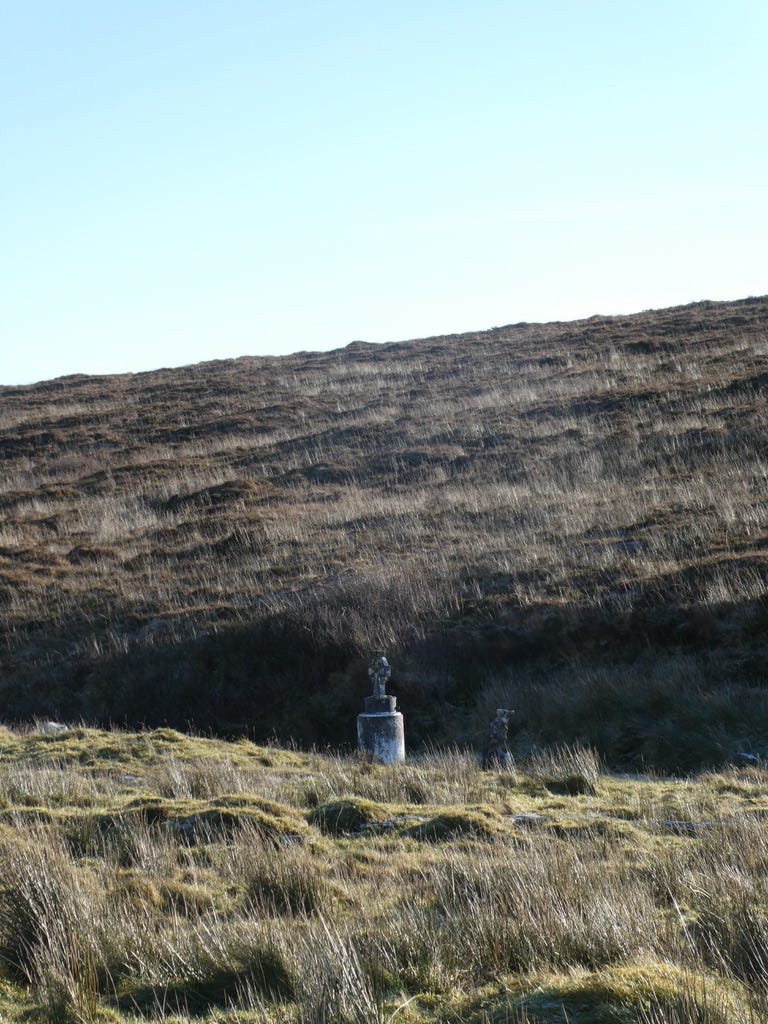Tobar An Athar Calbhach, Ballyelly, County Clare
Nobody seems to know who the bald priest was, but this place - known locally as ‘the bald priest’s well’ - is apparently named after him. What he would be doing up here is also a mystery. This is one of the remotest wells I’ve found. It is also, unusually, on top of a mountain. It’s quite a walk to get here, up the slopes of Slieve Elva, but on a clear January day there are few better things to do:
The Burren, in County Clare, is a unique landscape, full of contoured limestone mountains which look, in some lights, as if they could be on a different planet:
It’s one of my favourite parts of the country, and this is one of my favourite wells. How it became a holy well seems lost in the sea of time. It is nowhere near a church, a settlement, or anything much at all. It has no recorded patron saint and no ritual or calendar day associated with it. These days, it seems to be mainly visited by cows:
The well is not even by the side of a track. You need to step away from the green road that winds up the mountain when you see the concrete bollard with a Celtic Cross affixed to it that marks the well’s place in the sedge and bog:
The well itself is a clear pool of gently running water protected by a drystone wellhouse. You need to descend a few steps to get there:
When you do, you discover that it is not, after all, only cows that visit. People have left offerings (if this is the right word, which it may not be) which, as so often, seem to indicate requests for help with health problems. This well seems to have once been regarded as an eye well - a place whose waters could potentially heal eye ailments. It obviously still functions as one, at least to the older generations: note the old glasses case left on the lintel. Harder to see in this picture, and sadder, is a small child’s shoe, rotting and damp.
When I see these things I always wonder at the stories behind them.
Why would well water be running, as this water is? Because this is not a spring but an underground stream, which lies uncovered at this point before descending again into the depths of the mountain. This fact was confirmed in 1984 by a group of cavers from Bristol who were exploring some of the many underground limestone caverns which snake under the Burren. They discovered a cave, which was later named Poll an Tobar, ‘The Cave of the Holy Well’:
At the most easterly part of the cave the bottom of the holy well, Tobar an Athar Calbhach, was discovered. Many religious articles were found as well as many coins that date between 1913 and 1949. These relics should not be disturbed.
I love the fact that coins thrown into the well as an offering ended up on a cave floor hundreds of feet beneath the mountain. Meanwhile, up on the surface, the waters of the Atlantic, fed by the streams from the caves, stretch off to the Americas, boundless as the sky. How many offerings, over the centuries, have been quietly carried out to sea?
You can follow my ‘Fifty Holy Wells’ series as it develops by clicking on the Holy Wells link on the homepage menu.













About 25 years ago my sister and I were driving to a town in a rural county where she had recently bought a house. While approaching the town by a side road, we drove by a marker for a shrine, and immediately turned around to check it out. The shrine was located about a hundred yards off the road and was built to commemorate the spot where the first mass was said in the county in the 1850s. I think that there is something special about stumbling across a shrine or cross set out of the way someplace, off the beaten path. There is a sense of wonder that anyone would have taken the trouble to do it in the first place, apparently unmindful and unperturbed that it would rarely be seen by anyone. Therein lies the charm. This happened in California, where the chances of coming across such markers are few. Mores the pity. The discovery of this little shrine certainly enlivened our day.
This is a wonderful series Paul.
Did you sample the water? Is it potable?